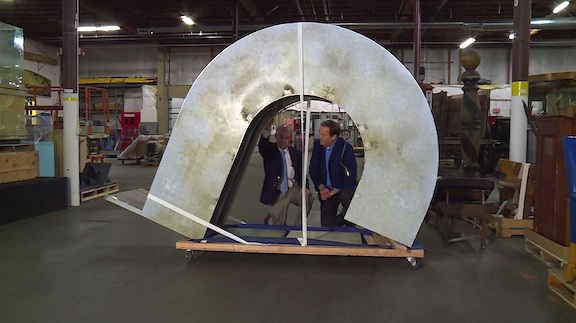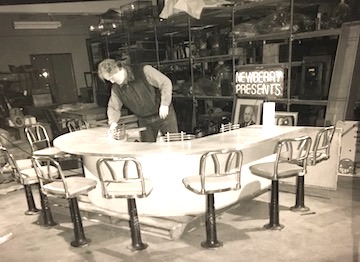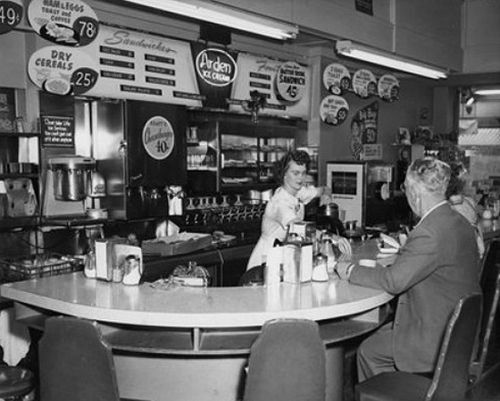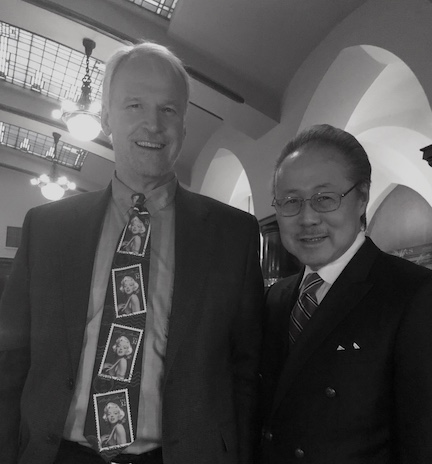
Historical advice usually comes from a book, or a class where some gray bearded funky old man in a musty suit jacket rambles on and on in a cloud of dandruff.
Doing history is different than studying history.
History museums Do History for everyone else.
Museum visitors walk from exhibit to exhibit, floor to floor, ready to be enthralled and amazed.
Doing history the right way makes sure they get enthralled and amazed. The first and most important part is getting the right stuff, the artifacts that tell a story.
Who better to tell than a Collection Manager? Here we go:
The top image shows the curved lunch counter from the old Portland Newberry’s on 5th and Alder.
It’s big and impressive, just the sort of thing that impresses museum visitors. But do they ever wonder how it got there before moving on to the next thing?
If they do, they know it wasn’t easy. Not an assembly piece that showed up in a box with instructions, and not something to pump up, it’s made of real world material that lasts.
Was it awkward, heavy, and impossible? Yes to all, but there it is in a museum storage warehouse.
Take A Seat For Historical Advice
Along with a big curved counter, the de-installation included a series of pedestal chairs that were bolted to the floor.
Good historical advice says prepare the pieces for moving before the movers show up. This is good advice for moving anything.
Before you hire a crew, make sure you know what you want them to do. If you don’t pack, they’ll pack for you, wrapping everything you should have thrown out, sold, or recycled like precious objects.
Don’t do that unless you want questionable stuff following you the rest of your life. Leave that work to museums.
That’s where you find things that should have been thrown away, but by some miracle, weren’t. How important is a box that vanilla flavoring came in decades ago? As important as anything else in a time-framed vignette.
No one keeps the box, except someone who has lived in the same house fifty years and never considered it in the way. Museum scouts find things like that in house ‘content’ donations.
One time a donor scooped up important materials of an important man at auction. The donor was a known sword collector. When he delivered the goods, one thing was missing. The sword. No one had a clue.
For the Newberry counter and stools, the preliminary work was loosening up the fasteners just enough to keep things in place, but not so loose that someone could pick it up and take it.
New Home For Newberry Counter
In the past, a local museum had an inter-departmental crew of ‘Gitters.’
When there was something to go get, they got it. They had their act fine tuned to ballet-like precision. This is the story of:
The Newberry Counter
Late one cold winter day the call came. The move call. The green light call.
The chief mover wheeled out of the warehouse in a rented box truck in minutes, picked up the crew minutes later, and headed for the center of town.
Would they be blocking downtown Portland rush hour traffic just ahead of a storm? Yes, they would.
Snow started just after we went inside. By the time we came out it had turned sharp edges soft.
With ropes, and pads, and dollies, we loaded everything up, mobilized the big stuff, and made a run.
We directed traffic, pulled the ramp, and tied everything we had to the walls. Drone footage would have made it look like a heist.
Getting big pieces with a motivated crew turned work into fun with each person a specialist in every phase of the operation from electrical to tie-down. It was a luxury to depend on them at a moment’s notice, but not for wasting time.
Get in, get out, go home. We should have had a crew tattoo.
That’s me setting the table in NW Portland inside the old Meier and Frank Receiving Depot on Everett and 14th. It was also a floor of museum off-site storage. Talking about that location used to be a firing offense.
The 40,000 square foot floor held wagons, automobiles, printing presses, and painting. It was full of rack storage systems holding chairs, tables, and catalogued boxes of archivally stored household stuff, like vanilla extract boxes.
Ninety thousand pieces and everything had it’s place in the custom alpha-numeric floor map.
Organized Historical Advice
Eventually we get overwhelmed by stuff we love. We love it so much it takes over our lives. Except that’s not love, it’s mental.
Museums hoard material for the purpose of public education and scholarly study. What’s your story?
Do you charge admission to your junk drawer, your garage, your storage unit? Is there any demand? Check for a waiting line before you answer.
Taking a flyer here and saying no, your private stuff is not on public display. Your secrets are safe.
If you live alone in a hoarder paradise, you’ll probably stay that way. If you date someone new and they see the mess, that’s probably the last date. After that happens too often, you’ll most likely shut it down and wait to be crushed to death by falling stacks of books and newspaper.
Or, you start weeding it out. And it’s not easy when you have enough room. Why not keep it?
The same question comes with memories.
For example, if a blogger writes a post about a Marine Corps dad leaving the service in 1955 after he got married and had kids because a local kid joined and did the hard stuff, then got married, had a kid, and left the service in 2021, give it a read.
There’s nothing more sad than a writer who won’t write, except a reader who won’t read. Not a problem here.
The best historical advice? Read a book, get a musty suit coat, and start writing. Leave a comment.
(See what I did there?)




